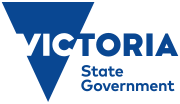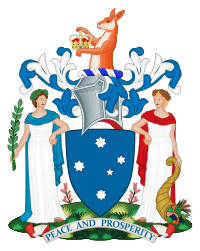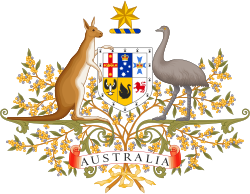Victoria State Government
The Victoria State Government is the executive administrative authority of the Australian state of Victoria.
| Victoria State Government | |
|---|---|
 | |
| Overview | |
| Established | |
| State | Victoria |
| Leader | Premier of Victoria[2] |
| Appointed by | Governor of Victoria[3] |
| Main organ | Executive Council of Victoria[4] |
| Ministries | 8 departments[5] |
| Responsible to | Parliament of Victoria |
| Annual budget | |
| Headquarters | Various locations throughout Melbourne[7] |
| Website | vic |
As a parliamentary constitutional monarchy, the State Government was first formed in 1851 when Victoria first gained the right to responsible government. Since the federation of Australia in 1901, Victoria has been a state, to which the Constitution of Australia regulates its relationship with the Australian Government. Under the Constitution, all states ceded legislative and judicial supremacy to the federal government but retain powers in matters not in conflict with federal law.[8][9]
The Victoria State Government enforces acts of Parliament passed by the Parliament of Victoria through government departments, statutory authorities, and other public agencies. The Government is formally presided over by the Governor of Victoria, who exercises their executive authority granted by the Constitution of Victoria through the Executive Council, a body consisting of senior cabinet ministers. In reality, both the governor and the Executive Council are largely ceremonial, with the premier and ministers having most authority over policy, appointments, and other executive orders made by the Governor-in-Council.[10]
The current head of government is Premier Daniel Andrews of the Labor Party, and the current head of state is Governor Linda Dessau.
Executive branch
Government in Victoria operates under the principles of the Westminster system as adapted in the Australian Constitution and of responsible government. Both systems and principles of governance have developed out of the United Kingdom, to which Victoria was previously a colony.
Executive power rests formally with the Executive Council, which consists of the governor and senior ministers. In practice, executive power is exercised by the premier, appointed by the governor, provided they can command the support of a majority of members of the Legislative Assembly. The Cabinet is the de facto chief policy making organ and consists of the premier and all ministers.
Legislative branch
Legislative power rests with the Parliament of Victoria, which consists of Elizabeth II, Queen of Australia, represented by the Governor of Victoria, and the two Houses, the Victorian Legislative Council (the upper house) and the Victorian Legislative Assembly (the lower house).
Judicial power
Judicial power is exercised by the Supreme Court of Victoria and a system of subordinate courts, but the High Court of Australia and other federal courts have overriding jurisdiction on matters which fall under the ambit of the Australian Constitution.
First Peoples' Assembly
In November 2019, the First People's Assembly (FPA) was elected, consisting of 21 members representing Aboriginal Victorians, elected from five different regions in the state, and 10 members to represent each of the state's formally recognised traditional owner corporations, excluding the Yorta Yorta Nation Aboriginal Corporation, who declined to participate in the election process.[11]
The main aim of the Assembly is to work out the rules by which individual treaties will be negotiated between the Victoria State Government and individual Aboriginal peoples. It will also establish an independent "umpire", the Treaty Authority, to oversee the negotiations between the Aboriginal groups and the Victoria State Government and ensure fairness. It will also establish a fund to help negotiations are take place on an even financial footing among the various groups, and debate and decide which ideas, laws, policies and rights will be the subject of treaty negotiations.[11]
The Assembly meets Upper House, seat of the Legislative Assembly.[11] It met for the first time on 10 December 2019,[12] and again met over two days in February 2020. The Assembly hopes to agree upon a framework, umpire and process before November 2022, the date of the next state election. The current Labor government under Daniel Andrews is supportive, but the Coalition had not made a clear commitment to supporting the treaty process.[13]
On 11 July 2020, the Victoria State Government announced that it would establish a truth and reconciliation commission for Aboriginal Australians in Victoria, the first ever in Australia, with the terms of reference to be worked out collaboratively. The 21 elected members of the Assembly would consult with their communities and work with the Victoria State Government to design the process. The announcement was welcomed by the community. The 2017 Uluru Statement from the Heart recommended that such a commission should be established across all of Australia.[14]
On 3 August 2020, the FPA held its first official negotiation meeting with Aboriginal Affairs Minister Gabrielle Williams.[15]
See also
References
- "Separation of NSW and Victoria". National Museum of Australia. Retrieved 25 June 2020.
- "The Premier". Victoria State Government. 23 July 2019. Retrieved 25 June 2020.
- "Governor's role". Governor of Victoria. 7 May 2020. Retrieved 25 June 2020.
- AUSTLII. "Constitution Act 1975 (Vic)". austlii.edu.au. Retrieved 1 July 2020.
CONSTITUTION ACT 1975 - SECT 87A - There shall be an Executive Council of the State of Victoria.
- "Departments". Victoria State Government. 18 December 2019. Retrieved 25 June 2020.
- "2019-20 Budget Update" (PDF). Department of Treasury and Finance. Retrieved 25 June 2020.
- "Victorian Government Directory". w.www.vic.gov.au. Retrieved 25 June 2020.
- "Commonwealth of Australia Constitution Act". Act of 1900.
- "Fact Sheet: Victoria's Parliamentary History". Parliament of Victoria. Parliament of Victoria. 25 February 2015. Retrieved 21 March 2019.
- "Constitution Act". Act of 1975 (PDF).
- Dunstan, Joseph (5 November 2019). "Victorian Aboriginal voters have elected a treaty assembly. So what's next?". ABC News. Retrieved 28 April 2020.
- Costa, Jedda; Dunstan, Joseph (11 December 2019). "'We are taking this place back': Treaty assembly sits in Victoria's Upper House". ABC News. Retrieved 28 April 2020.
- Dunstan, Joseph (29 February 2020). "'We've got a lot of eyes watching us': The weight of expectation on Victoria's treaty process". ABC News. Retrieved 28 April 2020.
- Thorne, Leonie (11 July 2020). "Victoria to establish truth and justice process as part of Aboriginal treaty process". ABC News. Australian Broadcasting Corporation. Retrieved 11 July 2020.
- Dunstan, Joseph (4 August 2020). "Victoria's First Peoples' Assembly holds first formal Aboriginal treaty talks with Government". ABC News. Australian Broadcasting Corporation. Retrieved 6 August 2020.

